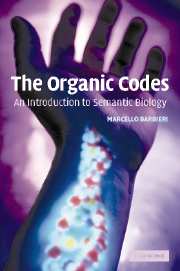Book contents
- Frontmatter
- Contents
- Foreword
- Dedication
- Acknowledgements
- Introduction
- Chapter 1 The microscope and the cell
- Chapter 2 Theories of evolution
- Chapter 3 A new model for biology
- Chapter 4 Organic codes and organic memories
- Chapter 5 The origin of life
- Chapter 6 Prokaryotes and eukaryotes
- Chapter 7 The Cambrian explosion
- Chapter 8 Semantic biology
- Chapter 9 A brief summary
- Appendix: Definitions of life
- Afterword
- References
- Index
Chapter 4 - Organic codes and organic memories
Published online by Cambridge University Press: 23 November 2009
- Frontmatter
- Contents
- Foreword
- Dedication
- Acknowledgements
- Introduction
- Chapter 1 The microscope and the cell
- Chapter 2 Theories of evolution
- Chapter 3 A new model for biology
- Chapter 4 Organic codes and organic memories
- Chapter 5 The origin of life
- Chapter 6 Prokaryotes and eukaryotes
- Chapter 7 The Cambrian explosion
- Chapter 8 Semantic biology
- Chapter 9 A brief summary
- Appendix: Definitions of life
- Afterword
- References
- Index
Summary
The existence of organic codes and organic memories is essentially an experimental problem, but experiments are planned and interpreted with criteria that are expressed in words. This inevitably requires some agreement about the terminology, and so this chapter starts with a few definitions. A code is defined as a correspondence between two independent worlds, and this definition immediately suggests a useful operative criterion. It means that the existence of a real organic code is based on (and can be inferred from) the existence of organic molecules – called adaptors – that perform two independent recognition processes. In the genetic code the adaptors are the transfer RNAs, but it will be shown that adaptors also exist in splicing and in signal transduction, which means that there are at least other two organic codes in real life. An organic memory is defined as a deposit of organic information, and this immediately qualifies the genome as an organic memory. It will be shown however that the determination state of embryonic cells is also a deposit of information, and so there are at least two different kinds of organic memory in real life. We conclude that codes and memories, as predicted by the mathematical model of epigenesis, do exist in the organic world. A conclusion that sets the stage for the problem of the next chapters, i.e. for the role that organic codes played in the history of life.
- Type
- Chapter
- Information
- The Organic CodesAn Introduction to Semantic Biology, pp. 93 - 120Publisher: Cambridge University PressPrint publication year: 2002



